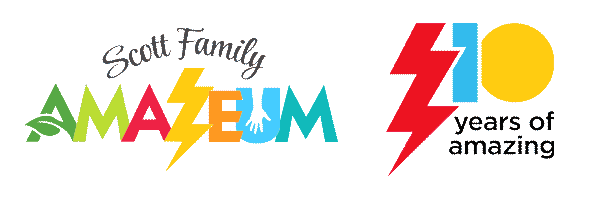A legacy of learning
Scott Family Amazeum Director of Education Mindy Porter grew up with a heart for exploring and a mind for science.
“A lot of people assume I have a teacher’s certificate or something, but my background is in science,” she said. “So, I kind of stumbled into the museum field.”
Porter may have stumbled into her current career choice, but she’s leading the charge in introducing students to the joys of scientific discovery.
She earned her bachelor’s degree in biology from Missouri State University and came to the Amazeum while it was in the planning stages more than nine years ago. Executive Director Sam Dean had recruited her from the Mid America Science Museum in Hot Springs, Ark., to join his staff for this new endeavor in Northwest Arkansas.
Porter relished the challenge of developing an educational approach from scratch. Since the Amazeum opened its doors over seven years ago, she has spearheaded efforts to introduce young students to the joys of exploration in the context of STEAM (Science, Technology, Engineering, Art, Mathematics) activities.
Porter believes STEAM instruction is even more crucial in reaching groups such as girls and people of color who have traditionally been underrepresented in science and math-based education. She said when working to instill a love of science in young people, the earlier the better.
“Usually, interest in STEAM is determined by eighth grade,” she said. “So if you don’t have an interest by then, it’s almost impossible to start that later. A lot of the work we do at the Amazeum is working with teachers in early childhood, pre-school and elementary to be equipping students with that opportunity, rather than saying, ‘We’ll wait ‘till high school.’ And then we’re all perplexed why girls don’t like (STEAM activities). Well, it’s because they’ve never been introduced to it.”
One novel approach that Porter and her colleagues use to share STEAM principles with young people is to appeal to participants’ empathy on engineering tasks. This approach came through a National Science Foundation-funded grant that was conducted in conjunction with the New York Hall of Science, which led activity development and research efforts.
Porter gave several examples of exercises designed to elicit empathy, including one in which the 8–12-year-old subjects are given cards with different scenarios where their grandmother may need physical assistance with everyday tasks such as opening a pill bottle or carrying in the groceries. The participant is then provided with loose parts – recycled nuts, bolts, screws, pipe cleaners, etc. – and allowed to either build a prototype or make a sketch of an engineering-based solution to grandma’s challenge.
In a similar experiment, a cutout of a dog has a collar with a message stating it is hungry, tired, or lonely. The participant then devises an engineering-based chain reaction that drops food in the bowl for the dog.
Professional researchers were present for these experiments, collecting data and conducting interviews.
“At the end of the day, the data overwhelmingly came back that, yes, adding that narrative element engaged girls longer in the engineering process and more engineering behaviors were displayed,” Porter said.
The Amazeum has many skill-based workshops to encourage students of all ages to embrace STEAM concepts. These include maker-related activities such as working with circuit boards, soldering, or using a sewing machine and stitching.
“We are proponents of hands-on learning,” Porter said. “Having real materials, real tools, real processes, and all that coming together allows you to learn by exploration instead of me telling you exactly what a solution should be.”
The Amazeum is also joining other museums across the nation in researching the role of how failure in STEAM-related activities could be used as a blueprint for future success. The research is funded by the National Science Foundation.
“How do we as educators support and facilitate when failure is happening? And is failure a helpful or hurtful thing?” Porter said.
She gave the example of a child having difficulty with a circuit block and how an educator responds to that.
“(The student) may say to themselves, ‘I can’t do science. I can’t do electricity. I’m never going to do that again.’ So how does the educator help support that child without stealing the learning moment?” she said. “It may require some redirection, some additional encouragement, more supplies, or maybe there’s something wrong with the block.”
To provide teachable moments for educators reacting to a child’s failure, video recordings are made by the research team to identify scenarios ripe for failure. They then show the clip to educators so they can gauge their response to the child’s struggle and whether the educator succeeded in effectively addressing these moments.
“And then they’re able to see things they may have missed in the moment,” Porter said. “And we can say, ‘Oh, that technique worked really well’ or ‘When you made that change, that was really helpful to the kid. Or even seeing something that only made the situation worse and discouraged them.”
Dean said it has been Porter’s commitment to continual learning, research, and experimentation that has made a positive impact on tens of thousands of children over the years.
“She’s so passionate about what she does, and that enthusiasm is contagious to students, fellow educators, and even her co-workers,” he said. “There have been many young people – especially young girls – who may have never been introduced to these concepts had they not had access to the STEAM and maker programs led by Mindy and the rest of the staff of the Amazeum.”
Both of Porter’s parents were schoolteachers, and they instilled in her a desire to be curious about the world around her. Though she may not have directly followed in her folks’ footsteps, Porter is carrying on their legacy of learning through her work at the Amazeum.
Author: Matt Shelnutt







